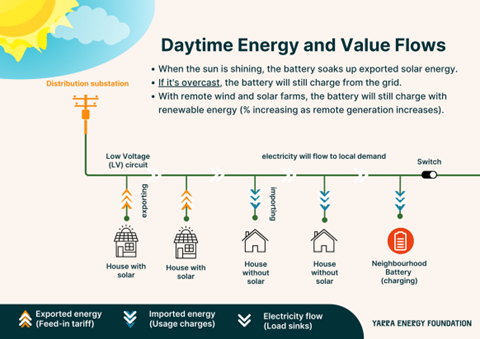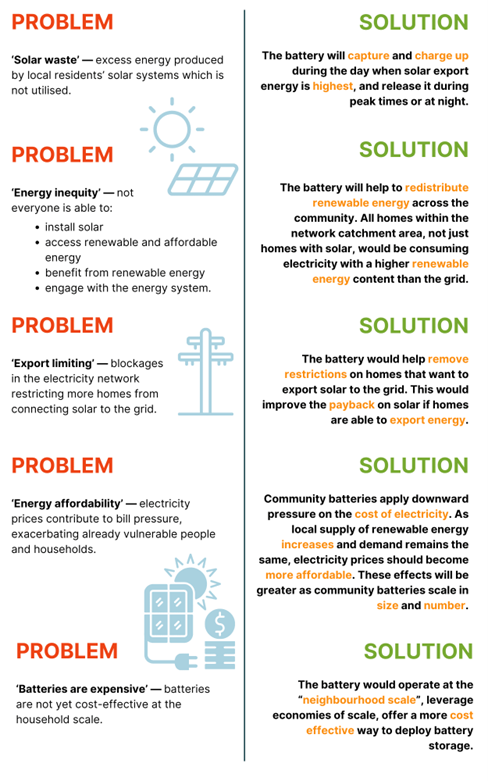Community Battery Project
In February 2023, Council secured a $500,000 federal government Batteries for Household Solar grant, in partnership with Yarra Energy Foundation (YEF) and the Noosa not-for-profit community organisation Zero Emissions Noosa Inc (ZEN Inc).
YEF have already installed and are operating a community battery in North Fitzroy Victoria.
The Federal Government’s Community Batteries for Household Solar program will deploy 400 community-scale batteries across Australia.
Round 1 of this program provided grant funding for 50 nominated locations across Australia. Noosaville was one of the nominated locations. Find out more about the federal government’s grant program.
What is a community battery?
A community battery is a locally shared battery within a community that enables storage of excess rooftop solar generated electricity, which can be used at a later time.
They essentially act as a ‘solar sponge’ – storing excess clean, cheap, and local solar energy (generated by rooftop solar arrays within the community) for use later in the day when demand is higher, and the sun is no longer shining.
Community batteries support renewable generation by providing energy storage for the excess solar that was generated during the day and making it available in the evening.


How does a community battery work?
Community batteries, often called neighbourhood batteries, are located in the low voltage network – at the local street level. They can be located on the ground or on poles. There are several factors that need to be considered when locating the community battery in Noosaville. These factors include:
- Available accessible land to locate the battery within Noosaville
- Proximity to the existing infrastructure in the low-voltage network
- Solar density within the local transformer
- Number of customers connected to the low voltage network
- Limitations on the network due to high solar export
- Environmental, visual, safety considerations
- Acceptance by the local community
Batteries are an important part in the transition to renewable energy. The Australian National University has provided a terrific explanation of how community batteries can benefit our local communities.
For in-depth information about neighbourhood batteries, visit the Yarra Energy Foundation.
Stay updated
To stay updated on the Noosaville Community Battery Project register your interest via email.
Frequently asked questions
Council gratefully acknowledge the dedicated work of ZEN Inc for their initial community education and engagement work on community batteries and Yarra Energy Foundation with the emerging electricity asset class of community batteries. Much of these FAQs have drawn upon their published work.
-
Noosa Council will be the owner and operator of the community battery. The community battery will be operated by a 3rd party specialist and will buy and sell electricity in the National Electricity Market (NEM).
-
There are a number of different ownership models for a community battery such as DNSPs such as Distributed Network Service Providers (DNSPs) such as Energex; electricity retailers or private investors. A Noosa Council owned model aims to provide the most equitable transition to renewable energy and provides decarbonisation benefits for the Shire. Profits from battery by participating in the National Energy Markets will be used for further decarbonisation projects across the shire in consultation with the community.
-
Rapid uptake in solar is causing ‘congestion’ in the electricity network, that is, more renewable energy than the grid can handle. Unfortunately, if renewable energy can’t be used, exported to the grid, or stored, it is wasted.
Community batteries address this problem by absorbing and storing excess energy from rooftop solar and releasing it during peak times when it is needed most.
Neighbourhood-scale batteries are a more affordable and cost-effective solution for renewable energy storage than individual household batteries, which are still prohibitively expensive for most people.
With community batteries, we can make our energy system more resilient, climate friendly, equitable, and affordable.

Image courtesy of Yarra Energy Foundation
-
No, all residents in the catchment area will automatically participate in the benefits of a community battery, at no additional cost to you. All arrangements with your retailer will remain the same. The power exported to the grid from local rooftops will charge the battery during the day when the sun is shining. Feed-in tariffs provided by your electricity retailer will remain exactly the same. The excess power from rooftop solar will be stored in the community battery. Then at night when you are using electricity which is usually drawn from a coal-fired power station, the community battery will increase the amount of renewable energy in your electricity consumption.
-
The renewable energy that is generated by Noosa rooftop solar is stored in the community battery for use at night to displace coal and gas generated electricity.
-
There are many reasons why some households can’t install solar on their roof. However the community battery helps all households to increase the amount of renewable energy that your family uses during the evening, regardless whether they have solar or not. Over the longer term, community batteries will also benefit everybody by deferring or avoiding costly grid upgrades.
-
Each battery consists of storage units and a control unit. Typically each of these units is similar in size to a large refrigerator (700mm W x 800mm D x 2100mm H) and the number of units depends on the chosen storage capacity. The community battery in Noosaville will follow the Noosa Design Principles and could be aesthetically pleasing through landscaping. Some community batteries have embraced community art .
-
The battery unit does make noise when it is charging and discharging. This occurs during the day when the sun shines and in the evening, especially during peak demand. Battery systems will typically include an air conditioning unit which will also contribute to the noise levels of the battery.
-
Yes, the batteries that we are proposing to install are safe. Our selection of suppliers and our testing of their technology follow a rigorous process to ensure that they operate safely and do not pose a fire threat and operate within Australian standards for Electro-Magnetic Fields (EMF).
-
There will be a strong focus on life-cycle sustainability in the selection of the Noosaville community battery. As an example, the battery selected for the Fitzroy North community battery, the Pixii PowerShaper, is by far the most sustainable battery model from a lifecycle analysis point of view out of more than a dozen options evaluated through an exhaustive assessment and evaluation process. The battery module manufacturers (Polarium) are the first in the world to announce manufacturing of battery modules made with 100% renewable energy and up to 95% of the physical materials used in the PowerShaper are recyclable.
-
An important element in choice of battery technology will be whether battery components can be recycled at end of life. A key factor in the battery manufacturer chosen by YEF was that up to 95% of all materials in battery cells can be recycled into producing new cells.
